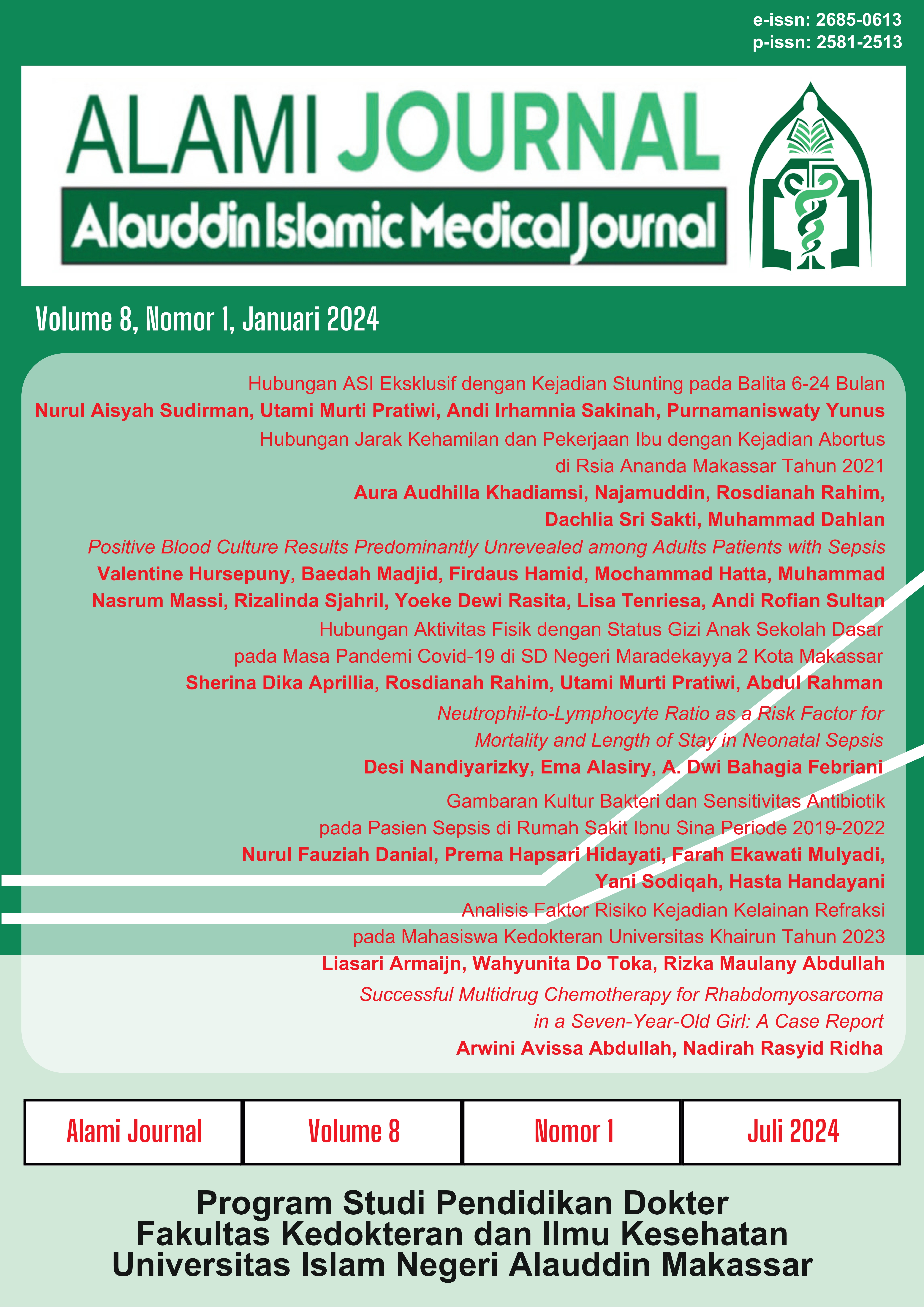Positive Blood Culture Results Predominantly Unrevealed among Adults Patients with Sepsis
Abstrak
Sepsis meningkat setiap tahun dan dapat mengancam jiwa. Diagnosis sepsis merupakan tantangan untuk mengidentifikasi agen penyebab infeksi. Penelitian ini bertujuan untuk mengetahui proporsi kultur darah positif pada pasien sepsis di Rumah Sakit Universitas Hasanuddin, Makassar. Kultur darah dikumpulkan dari 98 pasien dewasa dengan manifestasi sepsis. Studi cross-sectional dengan metode observasional deskriptif. Data yang telah diolah dalam statistik deskriptif digunakan untuk merangkum demografi pasien, perawatan, dan hasil. Analisis dilakukan dengan menggunakan IBM® SPSS Statistics 22. Tiga belas dari Sembilan puluh delapan sampel positif ditemukan mikroba patogen (13.26%). Kelompok lanjut usia memiliki persentase tertinggi (76.6%), delapan puluh tujuh pasien (88.77%) sudah diobati dengan antibiotik sebelum pengambilan kultur darah. Golongan cephalosporin merupakan antibiotik yang paling banyak diberikan sebanyak 72,4%. Pemberian terapi empiris sebelum pengambilan kultur darah dapat menurunkan sensitivitas hasil kultur. Kultur dari fokus infeksi perlu dilakukan untuk membantu dalam pertimbangan pengobatan antimikroba.
Referensi
Cheng MP, Stenstrom R, Paquette K, Stabler SN, Akhter M, Davidson AC, et al. Blood Culture Results Before and After Antimicrobial Administration in Patients With Severe Manifestations of Sepsis: A Diagnostic Study. Annals of Internal Medicine. 2019;171(8):547–54.
Robert Gauer, Damon Forbes, Nathan Boyer. Sepsis: Diagnosis and Management. American Family Physician. 2020;101(7):409–18.
Sweeney TE, Liesenfeld O, May L. Diagnosis of bacterial sepsis: why are tests for bacteremia not sufficient? Expert Review of Molecular Diagnostics. 2019;19(11):959–62.
Tamma PD, Miller MA, Cosgrove SE. Recalibrating our approach to the management of sepsis how the four moments of antibiotic decision-making can help. Annals of America Thoracic Society. 2021;18(2):200–3.
Sanjaya BD, Djuang MH, Muniro FD, Chiuman L. Sepsis Risk Factors in Elderly Patients At Royal Prima Medan General Hospital. Jambura Journal of Health Science and Research. 2022;4(3):596–603.
Fathi M, Markazi-Moghaddam N, Ramezankhani A. A systematic review on risk factors associated with sepsis in patients admitted to intensive care units. Australian Critical Care. 2019;32(2):155–64.
World Health Organization.. Sepsis. [Internet] 2023. Available from : https://www.who.int/news-room/fact-sheets/detail/sepsis
Bassetti M, Giacobbe DR, Vena A, Wolff M. Diagnosis and Treatment of Candidemia in the Intensive Care Unit. Seminars in Respiratory and Critical Care Medicine. 2019;40(4):524–39.
Evans T. Diagnosis and management of sepsis. Clinical Medicine. 2018;18(2): 146-9.
Sinha M, Jupe J, Mack H, Coleman TP, Lawrence SM, Fraley I. Emerging Technologies for Rapid Diagnosis of Sepsis. Clinical Microbiology Reviews. 2018;31(2):1–26.
Centers for Diseases Control and Prevention. Blood Culture Contamination : An Overview for Infection Control and Antibiotic Stewardship Programs Working with the Clinical Laboratory. [Internet]. U.S Department of Health and Human Services. 2023. Available from : https://www.cdc.gov/antibiotic-use/core-elements/pdfs/fs-bloodculture-508.pdf
De Rose DU, Perri A, Auriti C, Gallini F, Maggio L, Fiori B, et al. Time to positivity of blood culture could inform decisions on antibiotics administration in neonatal early-onset sepsis. Antibiotics. 2021;10(2):1–7.
Li Y, Guo J, Yang H, Li H, Shen Y, Zhang D. Comparison of culture-negative and culture-positive sepsis or septic shock: a systematic review and meta-analysis. Critical Care. 2021;25(1):1–9.
Scheer CS, Fuchs C, Gründling M, Vollmer M, Bast J, Bohnert JA, et al. Impact of antibiotic administration on blood culture positivity at the beginning of sepsis: a prospective clinical cohort study. Clinical Microbiology and Infection. 2019;25(3):326–31.
Ter SK, Rattanavong S, Roberts T, Sengduangphachanh A, Sihalath S, Panapruksachat S, et al. Molecular detection of pathogens in negative blood culture in the Lao People’s Democratic Republic. The American Journal of Tropical Medicine and Hygiene. 2021;104(4):1582–5.
Kabi, A., Mohanty, A., Kumar, S. K., Singh, V., Jha, M. K., and Gupta. Clinical spectrum and risk factors for hospital-acquired septicemia in a tertiary care centre of North-East India. Journal of Family Medicine and Primary Care. 2020;9(8): 3949-54.
Martínez ML, Plata-Menchaca EP, Ruiz-Rodríguez JC, Ferrer R. An approach to antibiotic treatment in patients with sepsis. Journal of Thoracic Disease. 2020;12(3):1007–21.
Thorndike J, Kollef MH. Culture-negative sepsis. Current Opinion in Critical Care. 2020;26(5):473–7.
Hirosawa T, Sakamoto T, Hanai S, Harada Y, Shimizu T. Effect of Prior Antibiotic Treatment on Blood Culture in an Outpatient Department of General Internal Medicine: A Retrospective Case–Control Analysis. International Journal of General Medicine. 2023;16(June):2709–17.
Yang L, Lin Y, Wang J, Song J, Wei B, Zhang X, et al. Comparison of clinical characteristics and outcomes between positive and negative blood culture septic patients: A retrospective cohort study. Infection and Drug Resistance. 2021;14(October):4191–205.
Strich JR, Heil EL, Masur H. Considerations for Empiric Antimicrobial Therapy in Sepsis and Septic Shock in an Era of Antimicrobial Resistance. The Journal of Infectious Diseases. 2021;222(Suppl 2):S119–31.
##submission.copyrightStatement##
##submission.license.cc.by-nc-sa4.footer##Once an article was published in the journal, the author(s) are: granted to the journal right licensed under Creative Commons License Attribution that allows others to share the work with an acknowledgement of the work's authorship. permitted to publish their work online in third parties as it can lead wider dissemination of the work. continue to be the copyright owner and allow the journal to publish the article with the CC BY-NC-SA license receiving a DOI (Digital Object Identifier) of the work.

